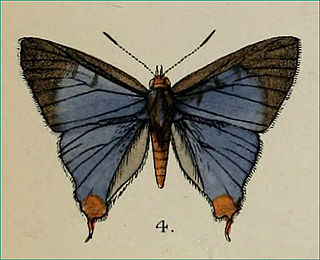Related Research Articles

Colotis amata, the small salmon Arab, is a small butterfly of the family Pieridae, that is, the yellows and whites. It is found in Africa and Asia.

Appias lalage, the spot puffin, is a small butterfly of the family Pieridae, that is, the yellows and whites, which is found in India, Indochina and Hainan.

Appias indra, the plain puffin, is a small butterfly of the family Pieridae, that is, the yellows and whites, which is found in south and southeast Asia.

Appias libythea, the striped albatross, is a small butterfly of the family Pieridae, that is, the yellows and whites, which is found in south and southeast Asia.

Curetis bulis, the bright sunbeam, is a species of butterfly belonging to the lycaenid family. It is found in Asia.

Hypermnestra helios is a species of swallowtail butterfly belonging to the Parnassinae family and is the sole member of the genus Hypermnestra. It is found in Iran, Afghanistan, Pakistan, Turkmenistan, Kirghizstan, Tajikistan, and Uzbekistan. It is locally common in desert habitats.

Cigaritis abnormis, the abnormal silverline, is a species of lycaenid or blue butterfly found in south India and Pakistan.

Tajuria jehana, the plains blue royal, is a species of lycaenid or blue butterfly found in Asia.

Tajuria cippus, the peacock royal, is a species of lycaenid or blue butterfly found in the Indomalayan realm.

Trichoptilus ceramodes is a moth of the family Pterophoridae that is found in Australia, including New South Wales and South Australia.
Antaeotricha pseudochyta is a moth of the family Depressariidae. It is found in Guyana and Grenada.

Dactylethrella bryophilella is a moth in the family Gelechiidae. It was described by Walsingham in 1891. It is found in the Democratic Republic of Congo (Equateur) and Gambia.
Dichomeris fracticostella is a moth in the family Gelechiidae. It was described by Walsingham in 1891. It is found in Ghana and Gambia.
Recurvaria sticta is a moth of the family Gelechiidae. It is found in Mexico (Guerrero).
Antaeotricha balanocentra is a moth of the family Depressariidae. It is found in Guyana.
Antaeotricha corvigera is a moth of the family Depressariidae. It is found in Guyana and Peru.
Antaeotricha macronota is a moth of the family Depressariidae. It is found in Colombia and Suriname.
Antaeotricha monosaris is a moth of the family Depressariidae. It is found in Guyana, French Guiana and Brazil.
Antaeotricha bicolor is a moth of the family Depressariidae. It is found in Brazil.
Ptilothyris purpurea is a moth in the family Lecithoceridae. It was described by Walsingham in 1897. It is found in the Central African Republic, the Democratic Republic of Congo, Equatorial Guinea and Nigeria.
References
- ↑ Antaeotricha Zeller, 1854 at Markku Savela's Lepidoptera and Some Other Life Forms.
- ↑ mothphotographersgroup
- ↑ Insect Life 2 (5): 153
| This article on a moth of the genus Antaeotricha is a stub. You can help Wikipedia by expanding it. |